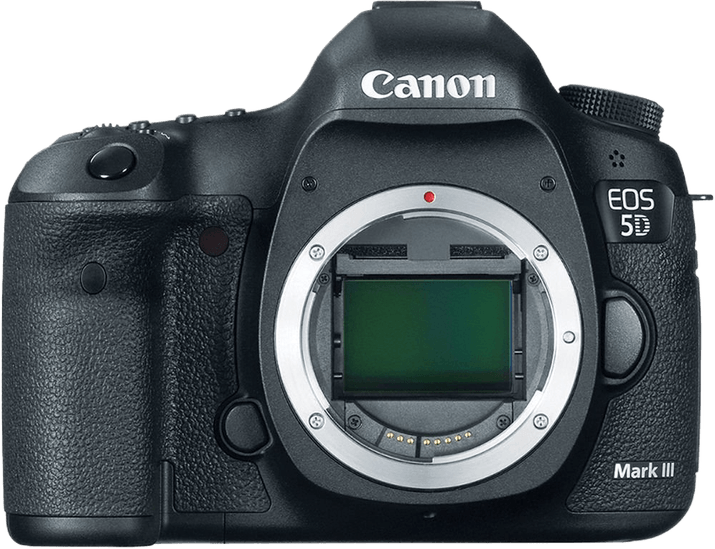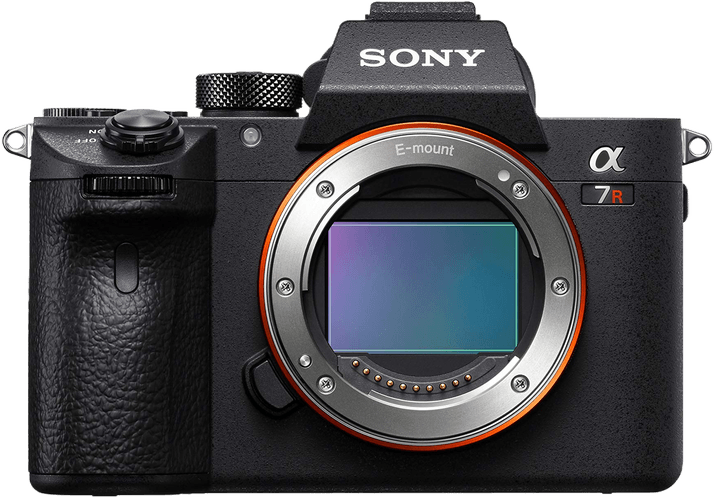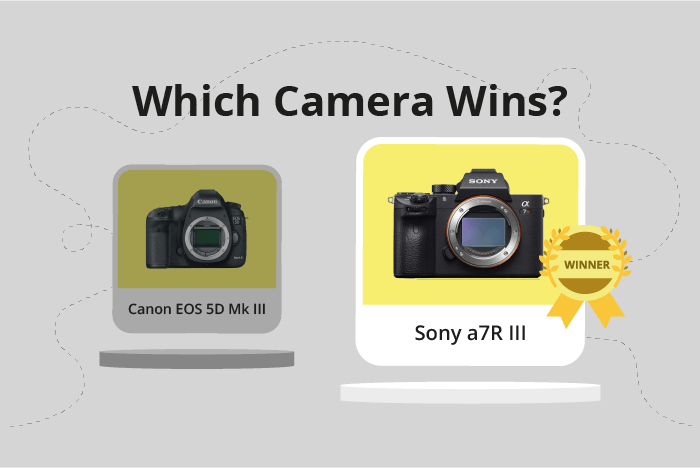Canon EOS 5D Mark III vs Sony a7R III Comparison
Canon EOS 5D Mark III

Sony a7R III

The Sony a7R III outperforms the Canon EOS 5D Mark III with a score of 83/100 compared to 65/100. Both cameras share similar specifications, such as their announcement and release years, 2012 and 2017, respectively. The Sony a7R III, however, has a lower launch price of $3200, compared to the Canon EOS 5D Mark III’s $3499.
The winning Sony a7R III is a mirrorless camera, making it lighter at 657g and smaller with dimensions of 127 x 96 x 74mm. In contrast, the Canon EOS 5D Mark III is a DSLR camera, weighing 950g and measuring 152 x 116 x 76mm. Despite its higher score, the Canon still has some advantages, such as its sturdy build and long-standing reputation in the photography world.
Taking all these factors into account, the Sony a7R III is the superior camera due to its higher score, lower price, and more compact design, while the Canon EOS 5D Mark III remains a reliable choice for those who prefer DSLR cameras.
Canon EOS 5D Mark III vs Sony a7R III Overview and Optics
The Sony a7R III outperforms the Canon EOS 5D Mark III in optics, with a score of 84/100 compared to the Canon’s 67/100. Both cameras share some specifications, such as the CMOS sensor type, full-frame sensor size, and their respective proprietary lens mounts – the Sony FE and Canon EF.
The Sony a7R III excels with its higher megapixel count, at 42.4 compared to the Canon’s 22.3, providing greater image resolution. Additionally, the Sony has a faster shooting speed of 10 frames per second, compared to the Canon’s 6, allowing for better action and sports photography. The Sony’s Bionz X processor and DXOMARK sensor score of 100 contribute to its superior image quality. Furthermore, the Sony a7R III has built-in image stabilization, which the Canon lacks, enabling sharper handheld shooting.
The Canon EOS 5D Mark III, while not as strong in optics, has the advantage of the extensive Canon EF lens system, which offers a wide variety of lenses for various shooting scenarios. The Canon’s Digic 5+ processor, while not as powerful as the Sony’s Bionz X, still provides good image processing capabilities.
In comparing the optics of these two cameras, the Sony a7R III is the clear winner due to its higher megapixel count, faster shooting speed, better sensor score, and built-in image stabilization. However, the Canon EOS 5D Mark III benefits from the vast Canon EF lens system, which may be a consideration for photographers already invested in Canon gear.
Canon EOS 5D Mark III vs Sony a7R III Video Performance
Comparing the video capabilities of the Canon EOS 5D Mark III and the Sony a7R III, both cameras have a video score of 56/100. Despite the similar scores, there are differences in their video specifications.
Both the Canon EOS 5D Mark III and the Sony a7R III lack built-in time-lapse functionality. The Canon 5D Mark III has a maximum video resolution of Full HD, with dimensions of 1920 x 1080, and can record at a maximum frame rate of 60fps. On the other hand, the Sony a7R III has a higher maximum video resolution of 4K, with dimensions of 3840 x 2160, but records at a lower maximum frame rate of 30fps.
The Sony a7R III is better when it comes to video resolution, offering 4K quality that provides more detail and clarity in video recordings compared to the Full HD offered by the Canon 5D Mark III. However, the Canon 5D Mark III has the advantage of a higher frame rate, which allows for smoother video playback and better slow-motion capabilities.
In terms of video capabilities, the Sony a7R III stands out with its 4K resolution, making it suitable for users who prioritize video quality and detail. The Canon EOS 5D Mark III, with its higher frame rate, is more suitable for users who require smooth motion in their videos, such as action or sports videographers.
Taking the specifications into consideration, photographers and videographers must decide which camera best suits their needs. The Sony a7R III is ideal for those seeking higher resolution, while the Canon 5D Mark III is better for users needing higher frame rates.
Canon EOS 5D Mark III vs Sony a7R III Features and Benefits
The Sony a7R III is the winner in terms of features, scoring 83/100, while the Canon EOS 5D Mark III scores 59/100. Both cameras have a screen, but the Sony a7R III has a smaller 3-inch screen compared to the Canon EOS 5D Mark III’s 3.2-inch screen. However, the Sony a7R III’s screen resolution is higher with 1,440,000 dots compared to the Canon EOS 5D Mark III’s 1,040,000 dots. Neither camera has GPS capabilities.
The Sony a7R III outperforms the Canon EOS 5D Mark III with its touchscreen, flip screen, WIFI, and Bluetooth capabilities, which the Canon EOS 5D Mark III lacks. These additional features make the Sony a7R III more convenient and user-friendly, as it allows for easier navigation, flexible shooting angles, and seamless connectivity with other devices.
The Canon EOS 5D Mark III has a larger screen, but this advantage is offset by its lower screen resolution and lack of additional features. The larger screen size does not necessarily provide a better user experience, as the Sony a7R III compensates with higher resolution and added functionality.
Based on these specifications, the Sony a7R III is evidently the superior camera in terms of features. Its touchscreen, flip screen, WIFI, and Bluetooth capabilities make it a more versatile and user-friendly option compared to the Canon EOS 5D Mark III. On the other hand, the Canon EOS 5D Mark III’s larger screen size is its only advantage, but it falls short in other aspects, making the Sony a7R III the clear winner.
Canon EOS 5D Mark III vs Sony a7R III Storage and Battery
The Canon EOS 5D Mark III outperforms the Sony a7R III in storage and battery, scoring 76 out of 100 compared to the Sony’s 65. Both cameras have two memory card slots and accept SD/SDHC/SDXC cards. However, the Canon also supports Compact Flash and UDMA cards, offering more storage options.
A significant advantage of the Canon 5D Mark III is its battery life, capable of capturing 950 shots compared to the Sony a7R III’s 650 shots. The Canon uses an LP-E6 battery, while the Sony uses an NP-FZ100 battery. Neither camera offers USB charging.
Although the Sony a7R III has a lower score in this category, it is worth noting that it is compatible with UHS-II SD cards, allowing for faster data transfer. This can be beneficial for photographers who need to quickly transfer high-resolution photos or videos.
To sum up, the Canon EOS 5D Mark III offers a longer battery life and more storage options, making it the better choice for those prioritizing storage and battery performance. The Sony a7R III, on the other hand, provides faster data transfer with its UHS-II compatibility, which may appeal to some users.
Alternatives to the Canon EOS 5D Mark III and Sony a7R III
Are you still undecided about which camera is right for you? Have a look at these popular comparisons that feature the Canon EOS 5D Mark III or the Sony a7R III:

